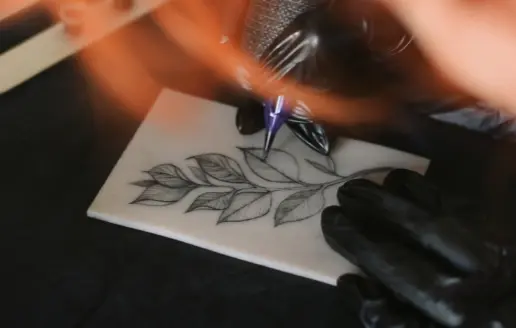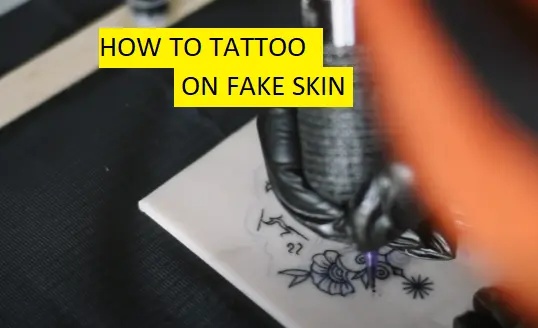How To Tattoo On Fake Skin
We know for beginners, it’s recommended to do tattooing on fake skin before getting tattoos on human skin. But every beginner needs to familiarize themselves and get acquainted with how to tattoo on fake skin. Here, we come up with detailed techniques for tattooing on fake skin. These methods will help you practice if you are new to tattooing.
how to tattoo on fake skin
Before working on human skin, practicing tattooing methods and polishing your art on artificial skin is a great idea. It is an outstanding method to practice various tattooing techniques without the pain of working on a live subject and to get at ease with the procedure. Most tattoo trainees use fake skin for practice purposes, so it’s also essential for them to follow the beginner’s guide.

Preparing the Fake Skin
Fake skin must be carefully prepared before tattooing to guarantee that the tattoo comes out correctly. The procedures for making artificial skin are as follows:
1. The area you will be working in should be cleaned.
2. Vaseline or petroleum jelly should be applied thinly to the artificial skin. This prevents the ink from passing into the material too rapidly.
3. Using tape or grips, fasten the fake skin to a surface like a table.
Stick the stencil
Before putting your stencil on the artificial skin, apply a thin coating of Old Spice to the region. The entire sheet of paper will appear moist as you carefully place the stencil where you would tattoo fake skin. This is very common. Put a thick book on top of the stencil for 24 hours to give it more durability. Compared to actual skin, the stencil slides off the artificial skin more easily.
Dry the area
Remove the stencil and make sure it has healed after 24 hours. Give it another 20 minutes to air if it hasn’t already.
You may set up your tattooing workstation while waiting. Even though there won’t be any blood involved, your tattoo station must still be correctly set up. This keeps a mess from arising and makes you comfortable with tattooing on human skin in the future! Additionally, you should wrap your machine because the ink will get all over it if you don’t.
Start tattoos
You’re now prepared to begin tattooing! While tattooing fake skin, you should go deeper than when tattooing natural skin. To prevent losing your stencil while working, try to wipe it away from the stencil. Vaseline should be used liberally since it aids in tapping. Start working your way from the start.
To train your hand to be flexible in the future, try stretching the skin like you tattoo on the natural human body. Before beginning to shade, finish all of the line work first. To resemble the body’s curves, it also helps to wrap the fake skin around a bottle, your leg, or a paper towel roll. Additionally, this raises the synthetic skin, making tattooing simpler.
Clean the skin
We have tried wiping alcohol, a soapy wash, and all the other cleaning agents you can think of, but this is one of the most challenging things to do correctly! However, a lot of Vaseline and a dry paper towel work amazingly. Use a dry paper towel to wipe the excess after spreading a thick coating over the tattoo and rubbing it in. Before it is spotless, this procedure might need to be performed several times.
Reuse skin
It is possible to reuse fake skin. I’ve seen several individuals show and sell their finished tattoos on artificial skin. Remember that just because you’ve inked a lot of fake flesh doesn’t always imply you’re ready to go on to tattooing real people.
Before moving on to the actual thing, much practice and knowledge of the risk of cross-contamination are required!
Tattooing Techniques on Fake Skin
1. Outlining
The initial process in tattooing is called outlining, which entails drawing a precise outline of the artwork. The following methods can be applied to artificial skin to produce a unique and clean design:
A. To make precise, clear lines, use a liner needle that is thin and pointed.
B. hold the machine at a constant angle and move it gently to produce accurate and straight lines. Avoiding shaky and irregular lines is crucial.
c. If the system freezes during the procedure, restart it to prevent overlaying lines.
2. Shading
Shading is used to provide depth and dimension to the tattoo. The following methods can be applied to shading accurately on artificial skin:
A. To make the ink’s impression more noticeable, use a shader needle, which is thicker than a liner needle.
B. Adjust the machine to control the needle’s depth; shaded parts should be more profound than highlighted areas.
C. Circularly move the needle back and forth to produce a smooth and equal shade transition.
3. Coloring
A tattoo’s design gains charm and brightness when color is added. The following methods can be used to color a tattoo on artificial skin:
A. Apply color to more prominent regions using a circular shader needle, which is the best tool.
B. To prevent errors, apply the ink slowly and deliberately.
C. Use the machine’s controls to regulate the needle’s depth to ensure the color is applied precisely and does not flow out.
Cleaning and Aftercare Of fake skin
To prevent any infections or irritations, it is crucial to properly clean the region after tattooing on artificial skin. The actions listed below ought to be taken:
1. Take off the surface’s skin.
2. To remove any leftover petroleum jelly and ink, use a moist cloth with mild soap.
3. Wash it under warm water and dry it with a fresh towel.
4. To encourage healing and prevent infections, use a thin layer of aftercare cream.
Faqs
Conclusion
The best approach for tattoo artists to practice new techniques and improve their art is to learn how to tattoo on fake skin. Preparing the artificial skin and adequately using the appropriate methods are crucial to achieving the most outstanding results. You may practice your abilities on artificial skin by using the procedures described here to make exquisitely realistic tattoos before applying them to natural skin.

